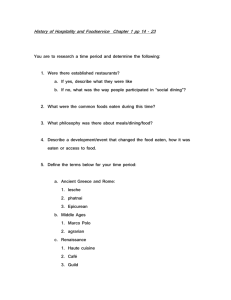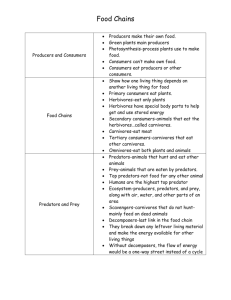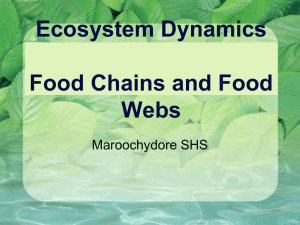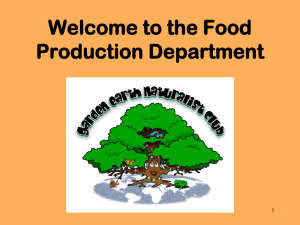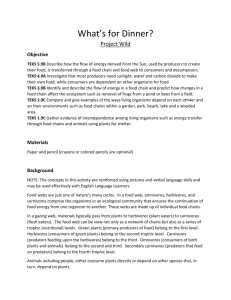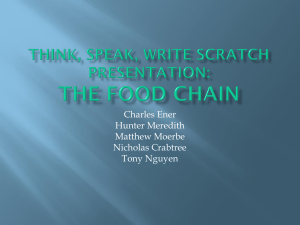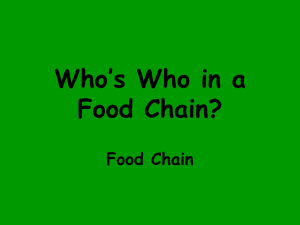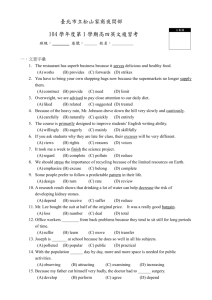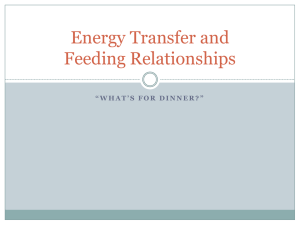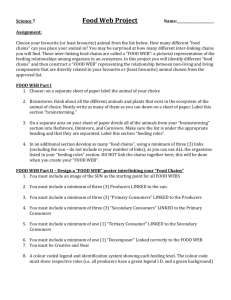What`s for Dinner?
advertisement
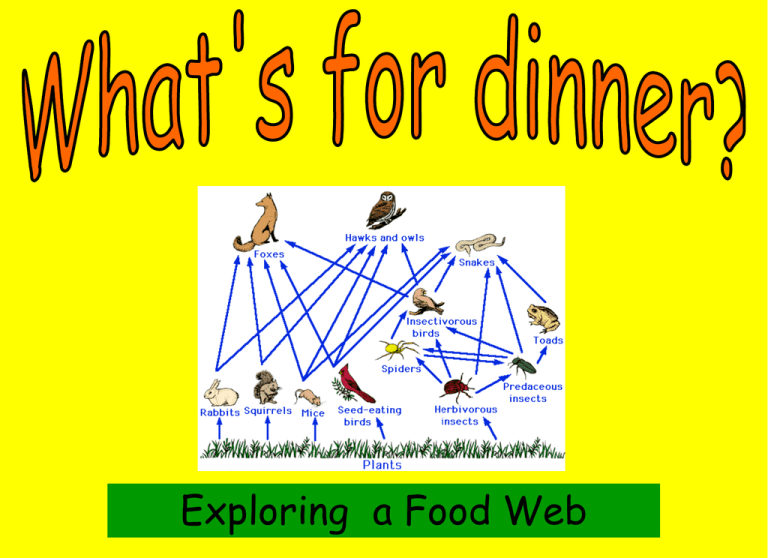
Exploring a Food Web Let’s Review… Herbivores Some animals do not eat other animals. They survive on plants and are known as “herbivores”. Carnivores Some animals, like the kingfisher, eat only other animals. These animals are called “carnivores”. Omnivores • Some animals, like us, eat both plants and animals. • These animals are called “omnivores”. Consumers • “Consume” means “eat”. • Animals are consumers because they “eat” (consume) food provided by plants or other animals. Producers • Plants are living organisms. They need nourishment to survive. • But… • Plants do not eat other plants or animals. • Plants are called producers, because they produce their own food using sunlight. Food Chains A food chain shows what is eaten. The fly is eaten by the thrush. Food Chains A food chain shows what is eaten. The lettuce is eaten by the rabbit. Food chains always start with a plant. The lettuce is eaten by the slug, the slug is eaten by the bird. Food Chains - a Reminder • A food chain shows which animals eat other animals or plants. • Plants don’t eat things. • A food chain starts with what gets eaten and the arrows point towards what does the eating. • Food chains only go in one direction. Where do the arrows point? The top of the food chain. Some animals are said to be at the top of the food chain. This is because they are not hunted by other animals. No other animal hunts the lion. The lion is at the top of the food chain. Can you think why? Food Webs • In the wild, animals may eat more than one thing, so they belong to more than one food chain. • To get the food they need, small herbivores may eat lots of different plants, and carnivores may eat many different animals. Food Webs We can show this by using a food web, which is just a more complicated version of a food chain. owl fox rabbits mice grass seeds berries Let’s do the following together. Answer the questions in your notebook. Take a look at the Food Web. 1. Which organisms are the producers? _________________ _________________ 2. Identify the consumers... C – Carnivore O – Omnivore H – Herbivore 1. Which organisms are the producers? Answer: Cacti, Bushes, Flowers, Ocotillo, Rabbit Brush, Sage Brush, etc. 2. Identify the consumers... C – Carnivore O – Omnivore H – Herbivore Answer: C-=Tarantulas, Scorpions, Lizards, Snakes, Fox, and Hawk. O = Lizards H = Insect, Rodents, Kangaroo Rats. 3. What would happen if the rodents and kangaroo rats died due to a severe drought? The snake would only have one food choice left, lizards. Also, it would give less choices for the fox and hawk to eat, making them compete for what is left. 4. Use one or two blank pages in your notebook for the following. Draw a simple food chain in your notebook. Add arrows to show the transfer of energy. See if you can add another food chain to make it a food web. How many can you add? Remember – Arrows go to the organism that does the eating! Arrows show the direction the energy has transferred! For example, the plants energy goes to the caterpillar and the caterpillar goes to the bird. 5. After you have finished your food web answer these questions. What would happen to your food web if the plants, died because of a flood? What would happen if a disease affected the top of your food chain? Breaking the Chain • Organisms living in a habitat depend on each other. • If one part of a food chain dies out or is greatly reduced, the consumers have to find alternative food, move away, or starve. Environmental Changes? There are lots of reasons why environmental changes affect animals. The most common are: • loss of habitat (woodlands cut down, rivers drying up, number of people in the world is growing at an alarming rate). • chemicals or pollution poison the animals. • hunting (for sport, their fur, tusks or meat). Caring for the Environment • It is in our own best interest to look after the world we live in. • If a habitat is lost or damaged, it has an effect on everything else, even if we do not see or understand it right away. • Remember - once something is gone, it’s gone forever!

